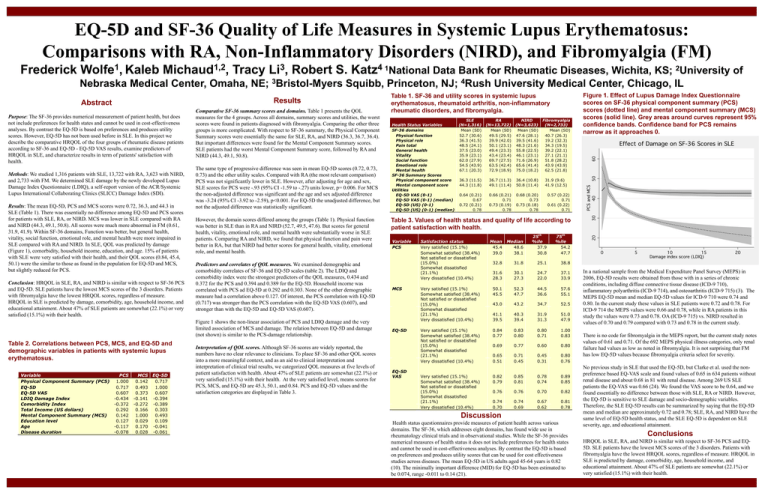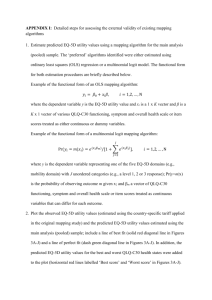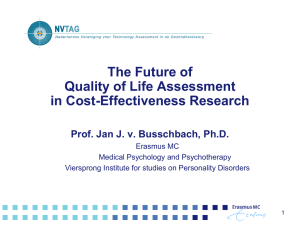
EQ-5D and SF-36 Quality of Life Measures in Systemic Lupus Erythematosus:
Comparisons with RA, Non-Inflammatory Disorders (NIRD), and Fibromyalgia (FM)
Frederick
1
Wolfe , Kaleb
1,2
Michaud ,
Tracy
3
Li ,
Robert S.
4
1
Katz National
2University
Data Bank for Rheumatic Diseases, Wichita, KS;
3
4
Nebraska Medical Center, Omaha, NE; Bristol-Myers Squibb, Princeton, NJ; Rush University Medical Center, Chicago, IL
Abstract
Purpose: The SF-36 provides numerical measurement of patient health, but does
not include preferences for health states and cannot be used in cost-effectiveness
analyses. By contrast the EQ-5D is based on preferences and produces utility
scores. However, EQ-5D has not been used before in SLE. In this project we
describe the comparative HRQOL of the four groups of rheumatic disease patients
according to SF-36 and EQ-5D - EQ-5D VAS results, examine predictors of
HRQOL in SLE, and characterize results in term of patients' satisfaction with
health.
Methods: We studied 1,316 patients with SLE, 13,722 with RA, 3,623 with NIRD,
and 2,733 with FM. We determined SLE damage by the newly developed Lupus
Damage Index Questionnaire (LDIQ), a self-report version of the ACR/Systemic
Lupus International Collaborating Clinics (SLICC) Damage Index (SDI).
Results: The mean EQ-5D, PCS and MCS scores were 0.72, 36.3, and 44.3 in
SLE (Table 1). There was essentially no difference among EQ-5D and PCS scores
for patients with SLE, RA, or NIRD. MCS was lower in SLE compared with RA
and NIRD (44.3, 49.1, 50.8). All scores were much more abnormal in FM (0.61,
31.9, 41.9). Within SF-36 domains, Function was better, but general health,
vitality, social function, emotional role, and mental health were more impaired in
SLE compared with RA and NIRD. In SLE, QOL was predicted by damage
(Figure 1), comorbidity, household income, education, and age. 15% of patients
with SLE were very satisfied with their health, and their QOL scores (0.84, 45.4,
50.1) were the similar to those as found in the population for EQ-5D and MCS,
but slightly reduced for PCS.
Conclusion: HRQOL in SLE, RA, and NIRD is similar with respect to SF-36 PCS
and EQ-5D. SLE patients have the lowest MCS scores of the 3 disorders. Patients
with fibromyalgia have the lowest HRQOL scores, regardless of measure.
HRQOL in SLE is predicted by damage, comorbidity, age, household income, and
educational attainment. About 47% of SLE patients are somewhat (22.1%) or very
satisfied (15.1%) with their health.
Results
Comparative SF-36 summary scores and domains. Table 1 presents the QOL
measures for the 4 groups. Across all domains, summary scores and utilities, the worst
scores were found in patients diagnosed with fibromyalgia. Comparing the other three
groups is more complicated. With respect to SF-36 summary, the Physical Component
Summary scores were essentially the same for SLE, RA, and NIRD (36.3, 36.7, 36.4).
But important differences were found for the Mental Component Summary scores.
SLE patients had the worst Mental Component Summary score, followed by RA and
NIRD (44.3, 49.1, 50.8).
Table 1. SF-36 and utility scores in systemic lupus
erythematosus, rheumatoid arthritis, non-inflammatory
rheumatic disorders, and fibromyalgia.
Figure 1. Effect of Lupus Damage Index Questionnaire
scores on SF-36 physical component summary (PCS)
scores (dotted line) and mental component summary (MCS)
scores (solid line). Grey areas around curves represent 95%
confidence bands. Confidence band for PCS remains
narrow as it approaches 0.
The same type of progressive difference was seen in mean EQ-5D scores (0.72, 0.73,
0.73) and the other utility scales. Compared with RA (the most relevant comparison)
PCS was not significantly lower in SLE. However, after adjusting for age and sex,
SLE scores for PCS were -.93 (95% CI -1.59 to -.27) units lower, p= 0.006. For MCS
the non-adjusted difference was significant and the age and sex adjusted difference
was -3.24 (95% CI -3.92 to -2.59), p<0.001. For EQ-5D the unadjusted difference, but
not the adjusted difference was statistically significant.
However, the domain scores differed among the groups (Table 1). Physical function
was better in SLE than in RA and NIRD (52.7, 49.5, 47.6). But scores for general
health, vitality, emotional role, and mental health were substantially worse in SLE
patients. Comparing RA and NIRD, we found that physical function and pain were
better in RA, but that NIRD had better scores for general health, vitality, emotional
role, and mental health.
Table 3. Values of health status and quality of life according to
patient satisfaction with health.
Predictors and correlates of QOL measures. We examined demographic and
comorbidity correlates of SF-36 and EQ-5D scales (table 2). The LDIQ and
comorbidity index were the strongest predictors of the QOL measures, 0.434 and
0.372 for the PCS and 0.394 and 0.389 for the EQ-5D. Household income was
correlated with PCS ad EQ-5D at 0.292 and 0.303. None of the other demographic
measure had a correlation above 0.127. Of interest, the PCS correlation with EQ-5D
(0.717) was stronger than the PCS correlation with the EQ-5D VAS (0.607), and
stronger than with the EQ-5D and EQ-5D VAS (0.607).
In a national sample from the Medical Expenditure Panel Survey (MEPS) in
2006, EQ-5D results were obtained from those with in a series of chronic
conditions, including diffuse connective tissue disease (ICD-9 710),
inflammatory polyarthritis (ICD-9 714), and osteoarthritis (ICD-9 715) (3). The
MEPS EQ-5D mean and median EQ-5D values for ICD-9 710 were 0.74 and
0.80. In the current study these values in SLE patients were 0.72 and 0.78. For
ICD-9 714 the MEPS values were 0.66 and 0.78, while in RA patients in this
study the values were 0.73 and 0.78. OA (ICD-9 715) vs. NIRD resulted in
values of 0.70 and 0.79 compared with 0.73 and 0.78 in the current study.
Figure 1 shows the non-linear association of PCS and LDIQ damage and the very
limited association of MCS and damage. The relation between EQ-5D and damage
(not shown) is similar to the PCS-damage relationship.
Table 2. Correlations between PCS, MCS, and EQ-5D and
demographic variables in patients with systemic lupus
erythematosus.
of
There is no code for fibromyalgia in the MEPS report, but the current study notes
values of 0.61 and 0.71. Of the 692 MEPS physical illness categories, only renal
failure had values as low as noted in fibromyalgia. It is not surprising that FM
has low EQ-5D values because fibromyalgia criteria select for severity.
Interpretation of QOL scores. Although SF-36 scores are widely reported, the
numbers have no clear relevance to clinicians. To place SF-36 and other QOL scores
into a more meaningful context, and as an aid to clinical interpretation and
interpretation of clinical trial results, we categorized QOL measures at five levels of
patient satisfaction with health. About 47% of SLE patients are somewhat (22.1%) or
very satisfied (15.1%) with their health. At the very satisfied level, means scores for
PCS, MCS, and EQ-5D are 45.3, 50.1, and 0.84. PCS and EQ-5D values and the
satisfaction categories are displayed in Table 3.
Discussion
Health status questionnaires provide measures of patient health across various
domains. The SF-36, which addresses eight domains, has found wide use in
rheumatology clinical trials and in observational studies. While the SF-36 provides
numerical measures of health status it does not include preferences for health states
and cannot be used in cost-effectiveness analyses. By contrast the EQ-5D is based
on preferences and produces utility scores that can be used for cost effectiveness
studies across diseases. The mean EQ-5D in US adults aged 45-64 years is 0.82
(10). The minimally important difference (MID) for EQ-5D has been estimated to
be 0.074, range -0.011 to 0.14 (21).
No previous study in SLE that used the EQ-5D, but Clarke et al. used the nonpreference based EQ-VAS scale and found values of 0.65 in 634 patients without
renal disease and about 0.68 in 81 with renal disease. Among 269 US SLE
patients the EQ-VAS was 0.66 (24). We found the VAS score to be 0.64, and we
found essentially no difference between those with SLE, RA or NIRD. However,
the EQ-5D is sensitive to SLE damage and socio-demographic variables.
Therefore, the SLE EQ-5D results can be summarized by saying that the EQ-5D
mean and median are approximately 0.72 and 0.78; SLE, RA, and NIRD have the
same level of EQ-5D health status, and the SLE EQ-5D is dependent on SLE
severity, age, and educational attainment.
Conclusions
HRQOL in SLE, RA, and NIRD is similar with respect to SF-36 PCS and EQ5D. SLE patients have the lowest MCS scores of the 3 disorders. Patients with
fibromyalgia have the lowest HRQOL scores, regardless of measure. HRQOL in
SLE is predicted by damage, comorbidity, age, household income, and
educational attainment. About 47% of SLE patients are somewhat (22.1%) or
very satisfied (15.1%) with their health.










